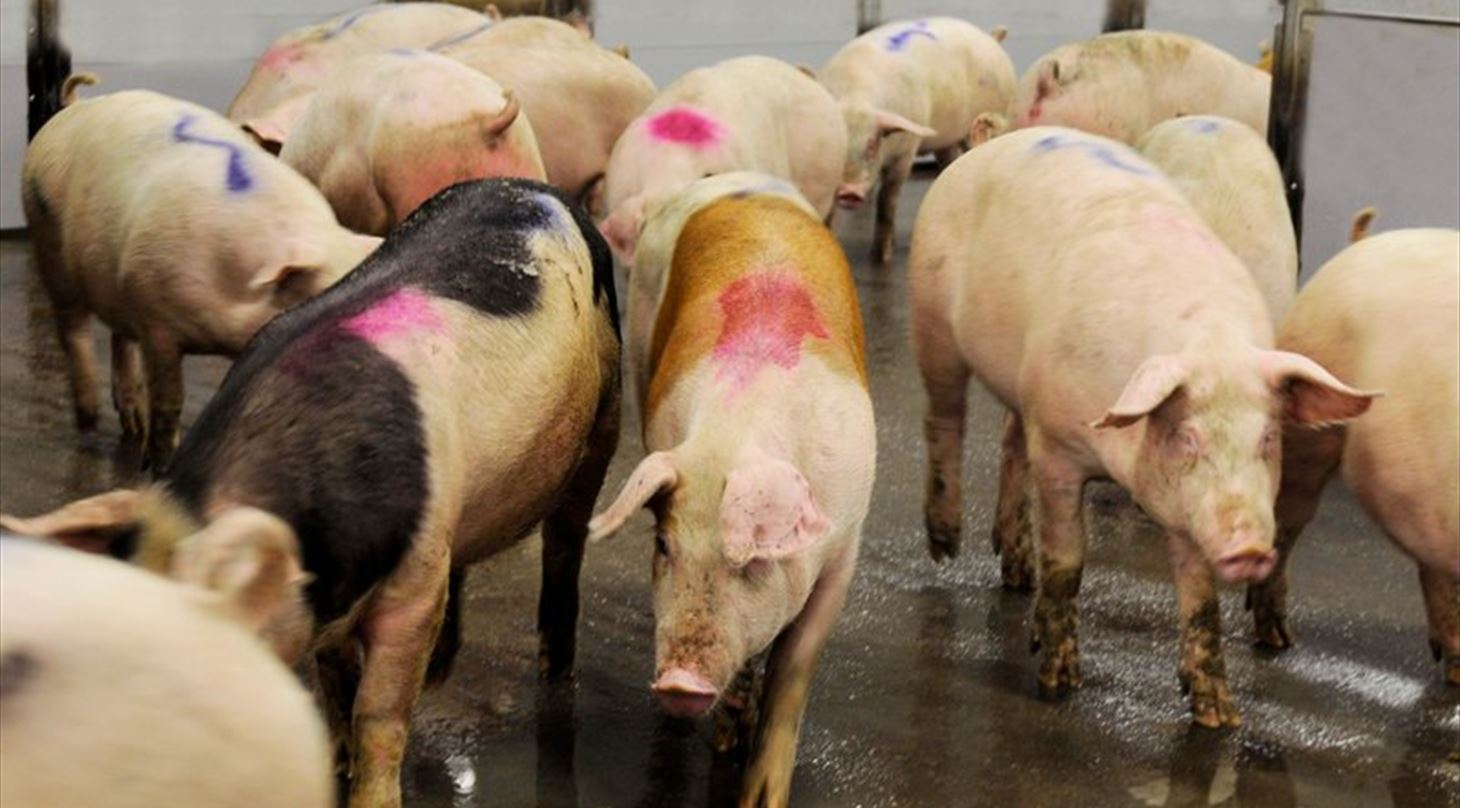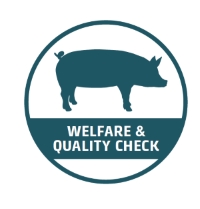
Good animal handling before slaughter is also good business
Press release from Danish Technological Institute (DMRI) 11. February 2019.
Now, animal welfare standards can be measured and calibrated for maximum efficiency. The Welfare and Quality Check (WQC) is a perfect tool for surveillance, benchmarking and communication of your animal welfare.
Increasing focus on improving animal welfare at the slaughterhouse
The majority of the earth’s population eat meat from animals that are bred and slaughtered under industrialized conditions. The farmers, haulers and the meat industry are responsible for ensuring that the animals are treated well and without unnecessary use of force. Within the EU, and in many other parts of the world, animal welfare at the time of slaughter is regulated by law. At the same time there is a growing public pressure in many countries to optimize animal welfare – also at the day of slaughter.
Animal welfare is not just about ethics and humanity it is also about common sense and good economy. DMRI have experienced that handling the animals in a gentle way before slaughter not only leads to good animal welfare, but also to good business – primarily because the quality of the meat is better from animals that are not stressed (due to e.g. lower drip loss and less variation in pH). In addition, gentle treatment also results in fewer injuries to the animals and survival of more animals until the time of slaughter – which reduces food waste.
It is always relevant to optimize animal welfare – even at well-run slaughterhouses
It will often be possible to improve animal handling – or procedures related to the live animals – even in well-run plants. New operators, old layout or machinery – there is always a good reason for re-focusing on how the live animals are being handled. Some of the typical problems that indicate the need to renew focus on animal welfare is e.g. a slow flow in production, increased need for trimming and increased drip loss – and often these problems are just accepted as unsolvable problems.

In WQC, the slaughterhouse will not only have an audit and receive a diploma, it will also receive an action plan based on the problem areas, which DTI identify at the visits.
The areas in the production that can often be optimized are as follows:
- Pick-up facility
A well-designed pick-up facility can reduce the amount of fighting among the pigs and thereby reduce the degree of skin damage. Furthermore, in a well-designed facility, the pigs are encouraged to walk more voluntarily to the truck, thus reducing the time used to load the truck.
- Transport
A well-designed vehicle with good ventilation can reduce the number of animals dying during transport and in the lairage. Furthermore, an optimal logistic planning system can help minimize the stress during loading and increase the meat quality measured by pH and drip loss.
- Unloading
Regarding unloading, it is important to optimize the design so that the pigs do not get frightened by, for example, reflections and noises, and so that they walk voluntarily to the lairage. This facilitates the unloading process, reduces the amount of labour and optimizes the working conditions.
- Lairage
During lairage, the pigs should be kept in small groups. Dividing big lairage pens into smaller units (approx. 15 pigs per unit) reduces fighting, since the pigs do not need to constantly re-establish their hierarchy. Research has shown that pigs in small groups are relaxed already after 10-15 min. This is beneficial due to the reduced amount of skin damage, which again reduces the amount of necessary trimming and probably optimizes the meat quality due to the decrease in drip loss.
- The race
In the race leading to the stunner, small groups are also easier to handle, and it is therefore easier to get the pigs to walk voluntarily. The number of pigs that fall is reduced, and this can reduce the amount of haemorrhages in the tenderloins and the hams.
- Stunning
An optimal stunning procedure is needed to avoid stress and negative reactions among the animals. Furthermore, the amount of haemorrhage, especially in the hams, can be reduced. A reduced amount of haemorrhages will minimize the need for trimming, thereby improving the economy of the slaughterhouses.
Good animal handling can be learned
DMRI educate and train slaughterhouse operators/managers round the world in correct animal handling. The course consists of a one-day survey of the current handling of animals by the operators and the mechanical functions at the plant. This is done to get insight, which will be used for the subsequent education and training. During e.g. a weekend, all operators and managers working at the slaughterhouse in the area from the reception to sticking will be given a course in correct handling of pigs. Managers will be given the course on day 2 and operators on day 3. The course is finalized with a test, and operators/managers passing the test will be given a diploma, which specifies that they are now educated by DMRI in live handling of pigs.
Welfare and Quality Check (WQC) is an audit system that improves both animal welfare and meat quality at the same time
When DMRI visit a slaughterhouse with the purpose of performing a WQC, the slaughterhouse will be surveyed by DMRI experts. The slaughterhouse staff will be educated in WQC both theoretically and practically in the production. At the same time, DMRI experts perform a WQC in order to set a zero-point level. At the end of the visit, a customized follow up plan will be agreed upon with the slaughterhouse management. The follow up plan will typically consist of re-visits, skype meetings, perhaps followed by video and photo documentation, or a combination of the above. Follow up is optional – but recommended – in order to secure a long lasting and significant effect of the program.
In WQC, the slaughterhouse will not only have an audit and receive a diploma, it will also receive an action plan based on the problem areas, which DMRI identify at the visits. The action plan includes suggestions on how to handle the identified problems. The problems are discussed regularly at meetings between the slaughterhouse and DMRI according to the follow up plan agreed upon. The slaughterhouse will have the opportunity to contact DMRI with questions (e.g. photo, video recordings) anytime needed, within the agreed follow up period.
The WQC graduation is divided into 4 main sections: unloading area, lairage area and driving to stunning, stunning and sticking process, and meat quality. Each section is divided into subsections, and the evaluation of each subsection is divided into a number of individual questions/surveillance points.
What is so special about WQC, is that it is not only based on management, slaughterhouse layout and animal-based indicators, but also on meat quality. WQC thereby gives the slaughterhouse a tool to optimize production economy – at the same time as animal welfare is improved.
‘In a world where there is a growing consciousness about animal welfare and sustainability, there is a constant need for focus on and re-thinking of the way we handle our animals. One way to secure compliance with legislation and consumer demands is to continuously educate the staff and implement valid monitoring procedures’, says Dorte Schrøder-Petersen, DMRI
About DMRI
As part of the Danish Technological Institute and with 60 years of close collaboration with the international meat industry, DMRI conducts research and provides equipment and consultancy services covering quality, safety and production of pork, cattle, sheep and poultry.
Contact
Dorte Schrøder-Petersen, +45 72201359, dsc@dti.dk, www.meat.dk.
Top photo:
In a world where there is a growing consciousness about animal welfare and sustainability, there is a constant need for focus on and re-thinking of the way we handle our animals.